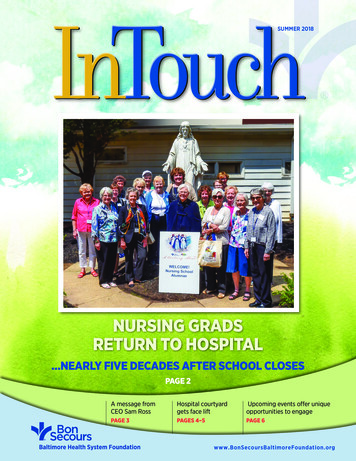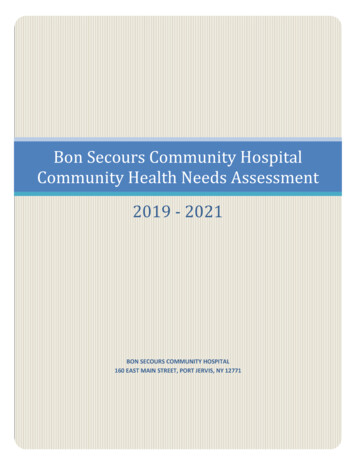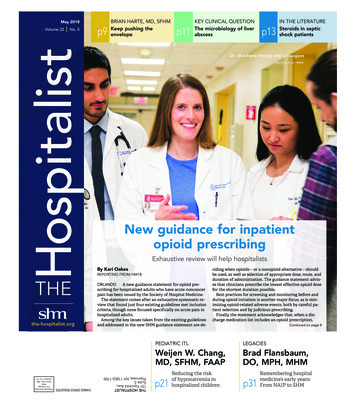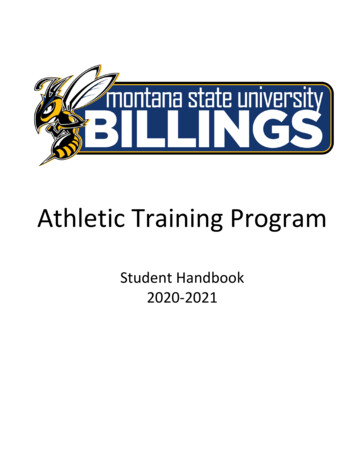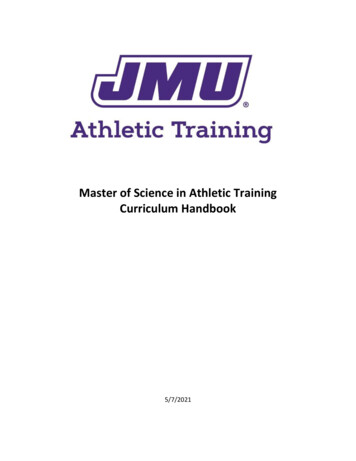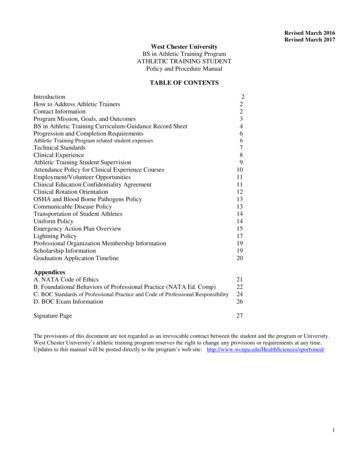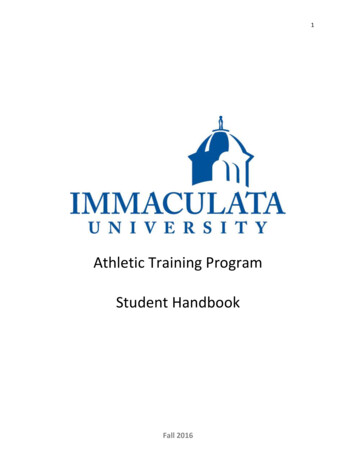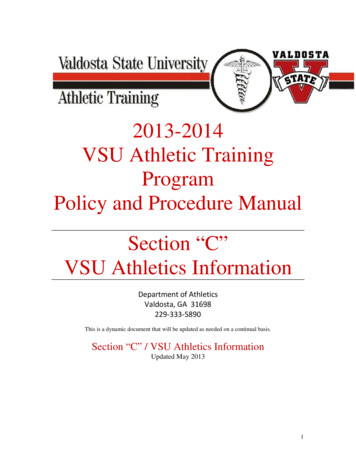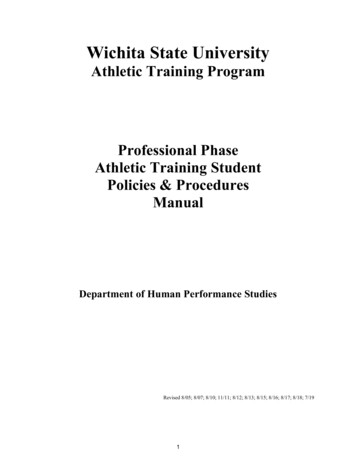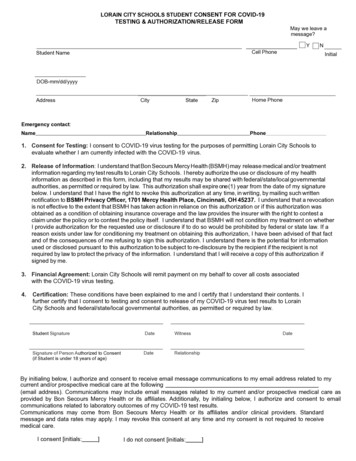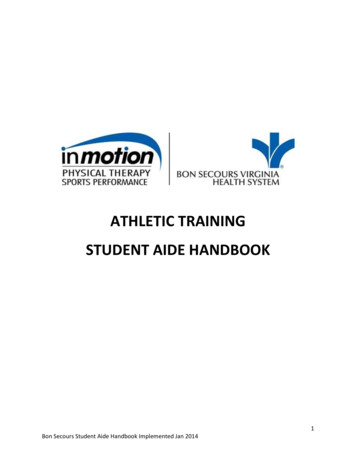
Transcription
ATHLETIC TRAININGSTUDENT AIDE HANDBOOK1Bon Secours Student Aide Handbook Implemented Jan 2014
Table of ContentsI. Bon Secours Student Aide Guidelines . 3II. Policies and Procedures . 4III. Student Aide Skills Check-off List . 5IV. Hours Log/Sign-in Sheet. 6V. ATC Evaluation of Student Aide . 6VI. Student Aide Evaluation of the program . 6VII. Scholarship Information. 7AppendicesA. NATA Official Statement on Student Aides . 8B. Student Aide Code of Conduct Contract . 9C. Student Aide Skills Checkoff Sheets . 10D. Athletic Trainer Evaluation of Student Aide . 16E. Student Aide Evaluation of the Program . 17F. Hours Log/Sign In Sheet . 18G. William and Mary Sports Medicine Camp Scholarship Application . 192Bon Secours Student Aide Handbook Implemented Jan 2014
I. Bon Secours Student Aide GuidelinesI. Student aides must be under the direct visual supervision of a licensed/certified AthleticTrainer when assisting with any athletic training services. Coaches and school administratorsmust not allow or expect student aides to act independently with regards to the evaluation,assessment, treatment and rehabilitation of injuries. Additionally, it is paramount that studentaides not be expected, asked or permitted to make “return to play” decisions. Specifically,student aides must not engage in the following activities:a. Interpreting referrals from other healthcare providersb. Performing evaluationsc. Making decisions about treatments, procedures or activitiesd. Planning patient caree. Independently providing athletic training services during team travelII. Student aides are also expected to follow the policies and procedures set by their siteCertified Athletic Trainer. These rules will include but are not limited to:a. Abide by the VA Board of Health regulations and NATA position statement for highschool athletic training student aidesb. Regular attendance as discussed by the student and the Athletic Trainerc. Proper dress as discussed by the student and Athletic Trainerd. Appropriate and suitable behavior both inside and outside the athletic training roomIII. Virginia State law states that under NO CIRCUMSTANCES is an athletic training studentaide to evaluate and/or treat injuries. This opportunity is to be utilized solely for the highschool students to observe the daily professional duties and responsibilities and an AthleticTrainer and can ultimately be a valuable educational experience. Under the direction andsupervision of the site Certified Athletic Trainer, the student aides can complete the followingtasks as it pertains to athletic training:a. Maintenance of the hydration stations (ie. Filling coolers and water bottles with iceand water, and cleaning of the equipment after use)b. Basic wound carec. Assistance with emergency responsed. Basic taping techniquese. Assisting with rehabilitation exercises3Bon Secours Student Aide Handbook Implemented Jan 2014
Please note that these duties and skills can only be completed and utilized if under the DIRECTSUPERVISION of the Athletic Trainer and only if the Athletic Trainer deems them ready to utilizethese skills.Bon Secours will not be held liable for high school athletic training student aides that practicebeyond what they have been approved to do. The certifications and state licensure of the siteCertified Athletic Trainer can and will likely be revoked if they are found in breach of the law byallowing students to perform skills that they are not educated enough to and not authorized bythe VA Board of Health to do.As this experience is a privilege, not a right, failure of the student aide to abide by any of theserules or regulations will result in dismissal from the high school’s athletic training observationand aide program at the discretion of the site Certified Athletic Trainer.II. Policies and Proceduresa. Expectations of Student Aidesi. It is important that student aides understand that participation in theprogram is an opportunity that is being extended to them; it is a privilege,not a right.ii. Student aides must have the Code of Conduct Contract signed and returnedbefore they will be allowed to participate in any program actives.iii. At no time is a student aide to present themselves to other students,athletes, coaches, parents, or administration as a certified athletic trainer. Ifthis occurs the student will be immediately removed from the program.1. Students are not permitted to act on their own and must onlycomplete tasks that have been assigned or cleared (i.e. completedskill check-off satisfactorily) by their supervising athletic trainer.iv. Students are expected to maintain the appropriate GPA needed forparticipation in extracurricular activities at their school. Students may beimmediately removed from the program or placed on probation by theathletic trainer, at their discretion.4Bon Secours Student Aide Handbook Implemented Jan 2014
b. Proper Behavior and Dressi. Athletic Training is a profession and as a member of the program studentswill be held to professional standards of dress and behavior when they areacting on its behalf.1. Students are expected to behave appropriately; this includes but isnot limited to language, volume, and attitude.2. Students are also expected to dress professionally. This means closedtoed shoes (tennis shoes or sneakers), appropriate length shorts forgirls, t-shirts (no tank tops or undershirts) preferable with schoolname or club logo. School dress code is also to be adhered to whileparticipating in program activates.c. Removal From Programi. The supervising athletic trainer has the right to remove any student aidefrom the program at their discretion. Depending on the severity of the issueat hand the student may be placed on probation; again this is at thesupervising athletic trainer’s discretion.III.Student Aide Skills Check-off ListA goal of this program is to educate the participants on different parts of the field of athletictraining and sports medicine. One way that this is accomplished is by teach student aidessimple taping and first aid techniques that will enhance their experience in the program.Students will have the opportunity to learn and practice skills and at the end of the season (orwhen they feel they are ready) will be evaluated on these skills. Students must complete theseskills according to the check list and earn at least an 80% in order to be allowed to performthese skills. Skills that the students have passed must only ever be performed under thesupervision of a certified athletic trainer. Sample Student Aide Skills Check-off Sheets areattached as Appendix C.a.b.c.d.Glove RemovalModalities (heat, ice bag, and ice massage application)First Aid (laceration and blister)Taping (thumb, finger, wrist, and ankle)5Bon Secours Student Aide Handbook Implemented Jan 2014
IV.Hours Log/Sign-in SheetStudents will be required to sign-in and log hours on a daily basis to avoid confusion at the endof a given time period (i.e. month, sports season, or semester). These log sheets will be locatedin a binder in the athletic training room and will be reviewed and signed off by the supervisingathletic trainer at the end of the given time period. Students should account for their timehelping prepare in the athletic training room, on the field/court time, and time spent cleaningup after a practice or event. A sample log sheet is attached as Appendix D.V.ATC Evaluation of Student AideAt the end of a given time period (i.e. month, sports season, semester) the athletic trainer willbe given an opportunity to complete an evaluation of their student aide(s). This evaluation willbe used by the athletic trainer to determine if the student aide will be able to continue theirwork/observation based on their overall rating. This evaluation can also be used to determineconditions of probation if the student aide is under performing or needs improvement in givenareas. A sample AT Evaluation of Student Aide is attached as Appendix E.VI.Student Aide Evaluation of the programAt the end of a given period (i.e. month, sports season, semester) the student aide will have theopportunity to complete an evaluation of the program. This evaluation will be a chance for thestudent aide to offer opinions and suggestions of the various aspects of the program that theyhave participated in. This will also be a chance for the student aides to have an openconversation about any concerns or aspects of the program that they were pleased with. Asample Student Aide Evaluation of the Program is attached as Appendix F.6Bon Secours Student Aide Handbook Implemented Jan 2014
VII. Additional Education/Scholarship InformationAs a way of promoting the growth of the field of Athletic Training, Bon Secours would like to beable to give as much information and support as possible to those interested in sports medicineor athletic training. We will strive to keep this section updated frequently as someinformation/requirements may be updated and some opportunities may no longer be available.a. W&M Sports Medicine Workshop Scholarshipi. The College of William and Mary annually puts on a four day long camp in thesummer time geared toward high school students interested in athletic trainingandsports medicine. Moreinformationcan be camp.htmii. The workshop itself offers an Ethnic Diversity Scholarship for the cost of theworkshop based on certain requirements. For more information on thisscholarship and the application see the above website.iii. Bon Secours would also like to offer their own scholarship for (part or all) of thecost of the workshop. This scholarship will have an application that any applicantmeeting the given qualifications is welcome to complete and submit. letic-trainers/i. Scholarship applications will be due annually on February 15. The BonSecours Athletic Training staff will review the candidates and choose arecipient who will be announced annually during the first week of Marchwhich is national Athletic Training month.ii. A copy of the application can be found online as well as in the back of thishandbook as Appendix G.b. College Scholarshipsi. Information on college scholarships in the field of athletic training and sportsmedicine can be found on various websites or by contacting the college oruniversity directly. Some of the best places to start your search, after you havefound an accredited program (caate.net) are:a. National Athletic Trainers’ Association: www.nata.orgb. Virginia Athletic Trainers’ Association: www.vata.usc. American College of Sports Medicine: www.acsm.orgd. Mid Atlantic Athletic Trainers’ Association: www.maata.shuttlepod.orge. Any district or state Athletic Trainers’ Association website7Bon Secours Student Aide Handbook Implemented Jan 2014
Appendix A:NATIONAL ATHLETIC TRAINERS’ ASSOCIATION:OFFICIAL STATEMENT ON PROPER SUPERVISION OF HIGH SCHOOL ATHLETICTRAINING STUDENT AIDESIntroduction:This Official Statement of the National Athletic Trainers’ Association provides support andguidance to school administrators and athletic trainers in the education and supervision of highschool students enrolled in sports medicine courses or participating in high school athletictraining programs. The goal of this statement is to continue to foster a positive, safe learningenvironment where students benefit from the instruction of qualified health care professionals.Official Statement:The NATA recognizes that allowing high school students the opportunity to observe thedaily professional duties and responsibilities of an athletic trainer can be a valuable educationalexperience. This unique experience may expose students to the foundations of various healthrelated careers as well as provide them with important life skills. Regardless of practice setting,it is understood that all athletic trainers must comply with their state practice act, BOCStandards of Practice when certified, and Code of Ethics when a member of NATA. These legaland ethical parameters apply when incorporating student aides outside of the classroom andwithin the activities of athletic programs.Student aides must be under the direct visual supervision of a licensed/certified athletictrainer when assisting with any athletic training services. Coaches and school administratorsmust not allow or expect student aides to act independently with regards to the evaluation,assessment, treatment and rehabilitation of injuries. Additionally, it is paramount that studentaides not be expected, asked or permitted to make “return to play” decisions. Specifically,student aides must not engage in the following activities:(1) Interpreting referrals from other healthcare providers(2) Performing evaluations(3) Making decisions about treatments, procedures or activities(4) Planning patient care(5) Independently providing athletic training services during team travel.8Bon Secours Student Aide Handbook Implemented Jan 2014
National Athletic Trainers’ Association3/09/10Appendix B:STUDENT AIDE CODE OF CONDUCT CONTRACTTHIS CONTRACT IS TO BE SIGNED BY BOTH THE STUDENT AND A PARENT/GURDIAN BEFORETHE STUDENT WILL BE ALLOWED TO PARTICIPATE ACTIVITIESI, , understand first and foremost that my involvement as astudent athletic training aide is a privilege and shall be treated as such. In addition, I am awarethe athletic training is a profession and I will be held to professional standards when I amrepresenting my school in the school building, in the community, and events where others mayrecognize my involvement or position as a student athletic training aide. I fully understand thatthe goal is to foster and encourage my interest in athletic training and other sports medicinefields. Being a student athletic training aide does not make me a certified athletic trainer orother healthcare provider and I should not be treated as one by the administration, coaches,officials, or student athletes; also, I will not present myself as a certified and/or licensedhealthcare provider. My goal is to learn about athletic training and sports medicine.Student SignatureParent/Guardian SignaturePrint NamePrint Name9Bon Secours Student Aide Handbook Implemented Jan 2014
Appendix C:STUDENT AIDE SKILLS CHECK-OFF SHEETSDirections: Place a checkmark within the box if the task is completed by the student. Total thenumber of checkmarks to assess passing of the skill. Student must receive at least an 80% topass.FIRST AID:Proper Removal of GlovesCheck Box/7P/FWith dominant hand, the student will remove other glove (non-dominant hand) bygrasping it just below the wristThe student will pull the glove down over non-dominant hand so that it is inside outThe student will hold the glove in their gloved handWith two fingers of the ungloved hand, the student will reach inside the glove withouttouching outside of gloveThe student will pull the glove down (inside out) over hand and remaining glovesThe student will discard the gloves in the proper containerThe student will wash their hands or use hand sanitizer (if not visibly soiled)Total ScorePassing at least 80%AT Initials and Date10Bon Secours Student Aide Handbook Implemented Jan 2014
Blister CareCheck Box/10P/FThe student makes sure that the athlete has signed in and treatment is recorded properlyThe student applies glovesThe student cleans and dries the area around the wound with the appropriate cleansingfluids or wipesThe student measures the size of the blister and gathers the appropriate materials tomanage the wound (donut pad, felt, second skin )The student applies the padding in the appropriate areaThe student covers the entire wound with dressing and secures the materialThe student gathers all used and soiled material and disposes of it in a proper containerThe student removes gloves without touching the soiled surfacesThe student washes their hands or applies hand sanitizer (if not visibly soiled)The student makes sure that the bandage is not too tight by checking circulationTotal ScorePassing at least 80%AT Initials and DateLaceration Wound CareCheck BoxThe student makes sure that the athlete has signed in and treatment is recorded properlyThe student applies glovesThe student assess wound (will this need stitches or bandage?)*If necessary the student applies gauze and applies pressureWhen the bleeding is controlled, the student cleans the area using the proper cleansingfluid or wipesThe student dries the area and applies anti-biotic ointmentThe student cover the wound with dressing or bandage and applies tape if neededThe student gathers all used and soiled materials and disposes off in proper containerThe student removes their gloves without touching contaminated surfacesThe student washes their hands or applies hand sanitizer (if not visibly soiled)The student makes sure that the bandage is not too tight by checking circulation/10P/FTotal ScorePassing at least 80%AT Initials and Date11Bon Secours Student Aide Handbook Implemented Jan 2014
MODALITIES:Moist Hot Pack ApplicationCheck BoxThe student makes sure that the athlete has signed in and recorded treatment properlyThe student positions individual in a comfortable and accessible treatment area positionThe student removes appropriate clothing including any bandagesThe student places a towel and pack cover on table, removes pack from hydrocollatorusing tongs, drip water off pack, close hydrocollator, prepares pack on tableThe student places the pack and several layers of towels on individual and checks individualfor comfort.The student sets the timer or notes the timeThe student checks with athlete to make sure they are not too hotThe student removes the pack and accompanying towels, places towels in laundry, andreturns the pack back into the hydrocollator/8P/FTotal ScorePassing at least 80%AT Initials and DateIce Bag ApplicationCheck BoxThe student makes sure that the athlete has signed in and treatment is recorded properlyThe student positions the athlete in a comfortable position and removes clothing andbandages as appropriateThe student fills the bag with sufficient amount of ice and removes airThe student applies ice to the correct area and secures the bag as appropriateThe student sets the timer or notes the timeThe student removes the ice bag after completion of treatment time or if they have anyabnormal discomfortThe student discards materials/7P/FTotal ScorePassing at least 80%AT Initials and Date12Bon Secours Student Aide Handbook Implemented Jan 2014
Ice Massage ApplicationCheck Box/7P/FThe student makes sure that the athlete has signed in and treatment is recorded properlyThe student positions the athlete and removes appropriate clothing and bandages asneededThe student places a towel under treatment areaThe student moves the ice cube/cup over the area being careful in areas around superficialnervesThe student sets a timer or notes the timeThe student removes the ice cube/cup at the completion of treatment time or if there isabnormal discomfortThe student discards used materialsTotal ScorePassing at least 80%AT Initials and Date13Bon Secours Student Aide Handbook Implemented Jan 2014
TAPING:ThumbCheck Box/8P/FThe student makes sure that the athlete has signed in and treatment is recorded properly*The student applies proximal anchors to the wrist*The student applies distal anchors around the distal phalax of the thumb*The student measures to create a fan of at least 3 strips*The student applies the fan to the distal anchor and then secures the fan to the originaldistal anchors along the side that is painful*The student applies distal portion of fan to the proximal anchor and re-anchorsThe student applies at least two figure 8 straps to provide additional supportThe student applies proximal anchors to secure the figure 8 strapsThe student completes the task within 5 minutesThe tape is neatThe tape is relatively wrinkle freeThe tape is functionalThe student makes sure that the tape is not too tight by checking circulationTotal ScorePassing at least 80%AT Initials and DateWristCheck Box/7P/FThe student makes sure that the athlete has signed in and treatment is recorded properlyThe student applies pre-wrap around the wrist and through the palm of the hand*The student applies circumferential anchor strips proximal to the wrist*The student applies anchor strip across the palm of the hand distal to the thumb*The student measures the distance between the anchors and makes a fan using 4-6interlocking strips*The student applies the fan to distal anchor (palmar or dorsal depending on pain)*The student positions the hand in slight flexion or extension (depending on pain)*The student secures the proximal portion of the fan to the wristThe student applies tape around the wrist and through the palm (pinching tape betweenthumb and first finger)The student completes the task within 3 minutesThe tape is neat and wrinkle freeThe tape is functionalThe student makes sure it is not too tight by checking circulationTotal ScorePassing at least 80%AT Initials and Date14Bon Secours Student Aide Handbook Implemented Jan 2014
Finger (Buddy Taping)Check Box/8P/FThe student makes sure that the athlete has signed in and treatment is recorded properlyThe student applies an anchor proximal to the injury site; including adjacent fingerThe student applies an anchor distal to the injury site; including adjacent fingerThe student completes the task within 3 minutesThe tape is neatThe tape is relatively wrinkle freeThe tape is functionalThe student makes sure that the tape is not too tight by checking circulationTotal ScorePassing at least 80%AT Initials and DateAnkleCheck Box/17P/FThe student makes sure that the athlete has signed in and treatment is properly recordedThe student places the ankle in dorsiflexion/neutral positionThe student applies adherentThe student applies heel and lace padsThe student applies pre-wrapThe student applies top anchors and an anchor around the arch/forefootThe student applies three stirrups (upward pressure on the lateral side- from medial tolateral) and horseshoe straps in an alternating sequenceThe student applies at least two figure 8 strapsThe student applies at least two complete heel locksThe student applies closure stripsThe student completes the task within 4 minutesThe tape does not compromise the 5th metatarsalThe tape is neatThe tape is relatively wrinkle freeThe tape job is functionalThe student makes sure the tape is not too tight by checking circulationTotal ScorePassing at least 80%AT Initials and Date15Bon Secours Student Aide Handbook Implemented Jan 2014
Appendix D:HOURS LOG/SIGN-IN SHEETName: Month:DateEventTime InTime OutCommentsTotal Hours for the Month:16Bon Secours Student Aide Handbook Implemented Jan 2014
Appendix E:ATHLETIC TRAINER EVALUATION OF STUDENT AIDEName: Date:Season/Sport:Evaluation AreaScoreCommentsEAP KnowledgeKnowledge of SuppliesGame/Practice SetupATR Maintenance55554444333322221111Work EthicPromptnessInitiativeAttitude towards professionAttitude towards athletesAttitude towards 11111. What did the student do well?2. What can the student work on/improve for next season?3. Was the student productive and a team player? (Did they enhance the group?)Comments:Name: Signature/Date:17Bon Secours Student Aide Handbook Implemented Jan 2014
Appendix F:STUDENT AIDE EVALUATION OF THE PROGRAMName: Date:How long have you been a member/aide:Evaluation AreaQuality of the programOpportunity to learn new skillsOpportunity to use skills learnedWere expectations met?Amount of hours required is appropriateEncouragement by the ATCWill you recommend this to 11111What are some things that you liked about the program?What did you dislike about the program?What would you like to see added to the program?Name: Signature/Date:18Bon Secours Student Aide Handbook Implemented Jan 2014
Appendix GSCHOLARSHIP APPLICATIONWILLIAM AND MARY SPORTS MEDICINE CAMP19Bon Secours Student Aide Handbook Implemented Jan 2014
WILLIAM AND MARY SPORTS MEDICINE CAMPSCHOLARSHIP APPLICATIONName: Date:Age: Grade:Mailing Address:City: State: Zip:Cell Phone Number:E-Mail Address:AcademicsGPA:Classes you have taken that pertain to Athletic Training and their importance:Student Aide Experience:Seasons you have been a student aide (minimum 2):Sports you have worked with:Responsibilities in:The ATR:At practices:At games:20Bon Secours Student Aide Handbook Implemented Jan 2014
Short ResponseWhat aspect of the profession of athletic training made you want to be astudent aide at your high school?Recall a time when you had to assist your athletic trainer with an injury.Describe what happened and what your role was.Why would attending this sports medicine clinic be beneficial to you as astudent aide at your high school?21Bon Secours Student Aide Handbook Implemented Jan 2014
EssayIn 750 words or less, explain why you think that it is beneficial to have acertified athletic trainer available to work with high school athletic programs.22Bon Secours Student Aide Handbook Implemented Jan 2014
William and Mary Sports Medicine ClinicEvaluation of the Student AideTo be filled out by the Certified Athletic TrainerStudent: Date:Evaluation AreaScoreCommentsEAP KnowledgeKnowledge of SuppliesGame/Practice SetupATR Maintenance55554444333322221111Work EthicPromptnessInitiativeAttitude towards professionAttitude towards athletesAttitude towards 1111Please feel free to make any additional comments about your student inregards to why they should receive this scholarship.Name: Signature/Date:23Bon Secours Student Aide Handbook Implemented Jan 2014
Secours Athletic Training staff will review the candidates and choose a recipient who will be announced annually during the first week of March which is national Athletic Training month. ii. A copy of the application can be found online as well as in the back of this handbook as Appendix G. b. College Scholarships i.
